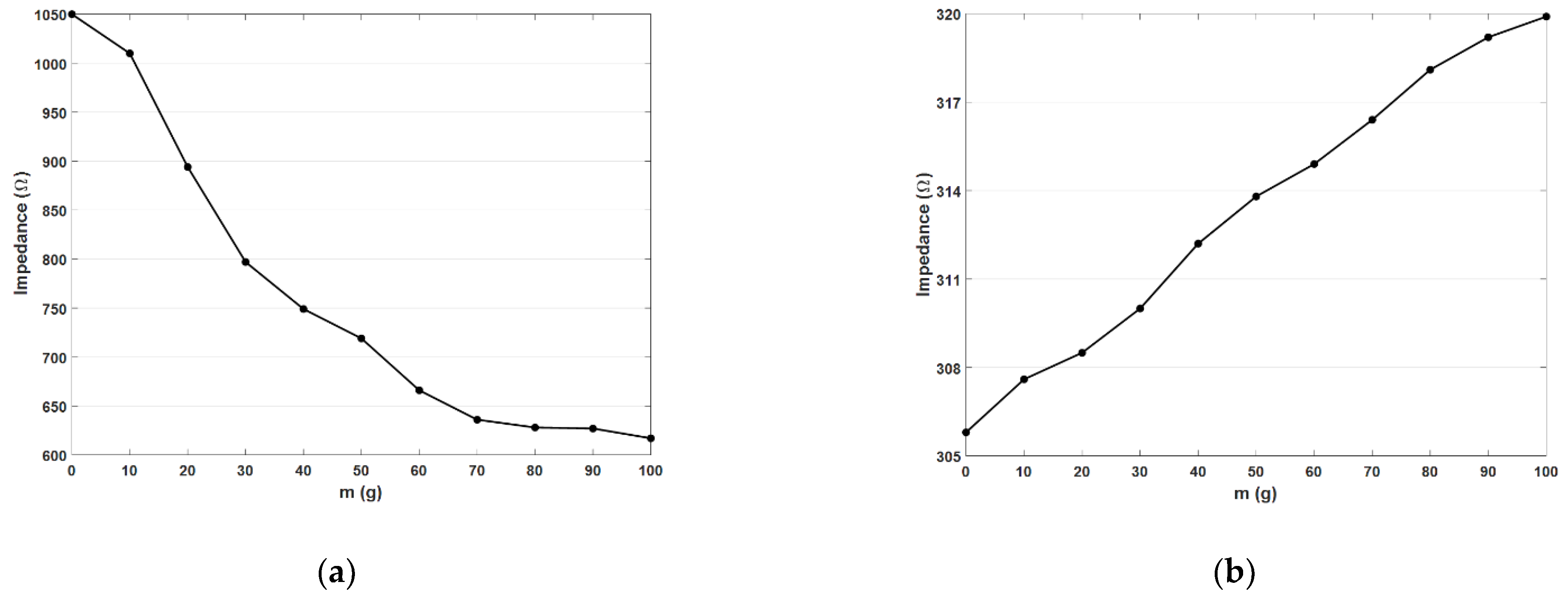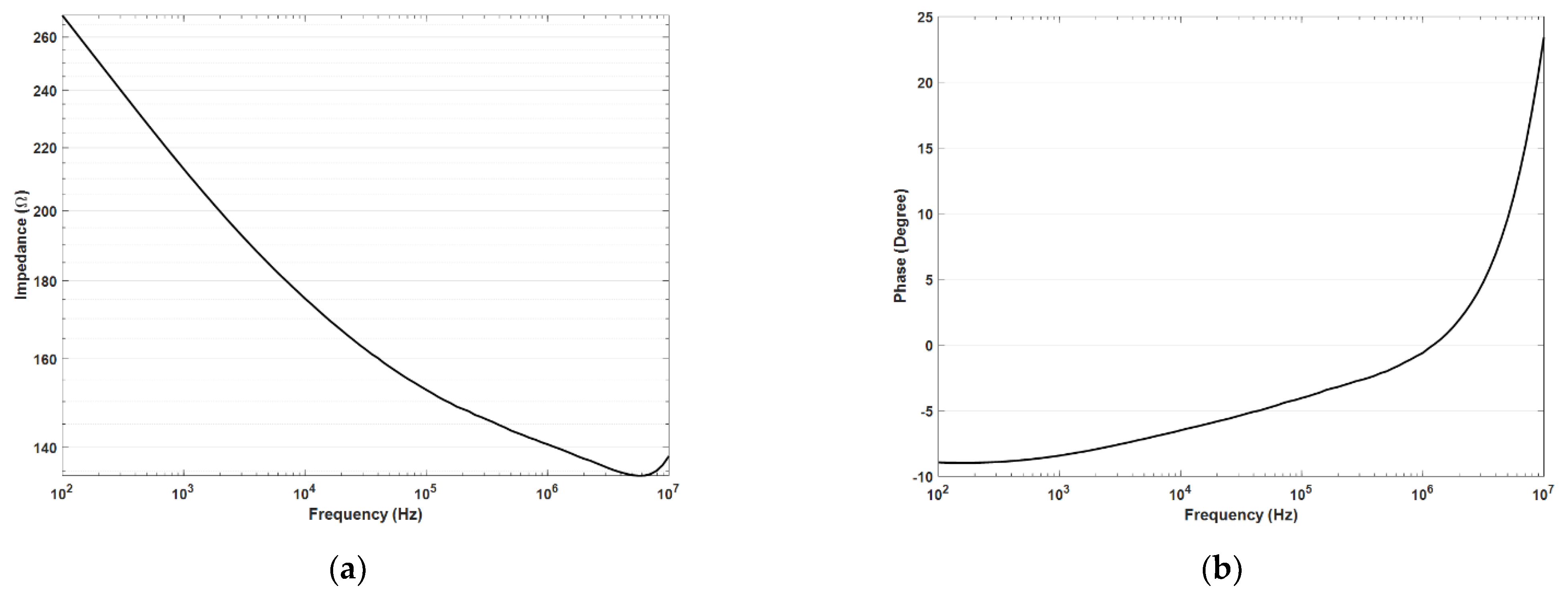Composites of Functionalized Multi-Walled Carbon Nanotube and Sodium Alginate for Tactile Sensing Applications †
Abstract
:1. Introduction
2. Materials and Sensor Fabrication
3. Results
3.1. Pressure Responses of the Sensors
3.2. AC Behaviors of the Sensors
4. Conclusions
Author Contributions
Funding
Institutional Review Board Statement
Informed Consent Statement
Data Availability Statement
Conflicts of Interest
References
- Alizadeh Sahraei, A.; Ayati, M.; Baniassadi, M.; Rodrigue, D.; Baghani, M.; Abdi, Y. AC and DC electrical behavior of MWCNT/epoxy nanocomposite near percolation threshold: Equivalent circuits and percolation limits. J. Appl. Phys. 2018, 123, 105109. [Google Scholar] [CrossRef]
- Singh, K.; Sharma, S.; Shriwastava, S.; Singla, P.; Gupta, M.; Tripathi, C.C. Significance of nano-materials, designs consideration and fabrication techniques on performances of strain sensors—A review. Mater. Sci. Semicond. Process. 2021, 123, 105581. [Google Scholar] [CrossRef]
- Yee, M.J.; Mubarak, N.M.; Abdullah, E.C.; Khalid, M.; Walvekar, R.; Karri, R.R.; Nizamuddin, S.; Numan, A. Carbon nanomaterials based films for strain sensing application—A review. Nano-Struct. Nano-Objects 2019, 18, 100312. [Google Scholar] [CrossRef]
- Khalid MA, U.; Chang, S.H. Flexible strain sensors for wearable applications fabricated using novel functional nanocomposites: A review. Compos. Struct. 2022, 284, 115214. [Google Scholar] [CrossRef]
- Tong, S.; Yuan, W.; Liu, H.; Hu, N.; Zhao, C.; Zhao, Y. Linear strain sensor made of multi-walled carbon nanotube/epoxy composite. Mater. Res. Express 2017, 4, 115008. [Google Scholar] [CrossRef]
- Park, S.; Vosguerichian, M.; Bao, Z. A review of fabrication and applications of carbon nanotube film-based flexible electronics. Nanoscale 2013, 5, 1727–1752. [Google Scholar] [CrossRef] [PubMed]
- Li, X.; Cao, L.; Chen, L.P. Multifunctional ionic conductive hydrogels based on gelatin and 2-acrylamido-2-methylpropane sulfonic acid as strain sensors. Biochem. Eng. J. 2022, 187, 108606. [Google Scholar] [CrossRef]
- Yang, J.; Sun, X.; Kang, Q.; Zhu, L.; Qin, G.; Chen, Q. Freezing-tolerant and robust gelatin-based supramolecular conductive hydrogels with double-network structure for wearable sensors. Polym. Test. 2021, 93, 106879. [Google Scholar] [CrossRef]
- Menna, E.; Della Negra, F.; Dalla Fontana, M.; Meneghetti, M. Selectivity of chemical oxidation attack of single-wall carbon nanotubes in solution. Phys. Rev. B 2003, 68, 193412. [Google Scholar] [CrossRef]
- Cai, Y.; Shen, J.; Ge, G.; Zhang, Y.; Jin, W.; Huang, W.; Dong, X. Stretchable Ti3C2Tx MXene/Carbon Nanotube Composite Based Strain Sensor with Ultrahigh Sensitivity and Tunable Sensing Range. ACS Nano 2018, 12, 56–62. [Google Scholar] [CrossRef] [PubMed]
- Mohiuddin, M.; Van Hoa, S. Electrical resistance of CNT-PEEK composites under compression at different temperatures. Nanoscale Res. Lett. 2011, 6, 419. [Google Scholar] [CrossRef] [PubMed] [Green Version]
- Chang, J.; Liang, G.; Gu, A.; Cai, S.; Yuan, L. The production of carbon nanotube/epoxy composites with a very high dielectric constant and low dielectric loss by microwave curing. Carbon 2012, 50, 689–698. [Google Scholar] [CrossRef]




Publisher’s Note: MDPI stays neutral with regard to jurisdictional claims in published maps and institutional affiliations. |
© 2022 by the authors. Licensee MDPI, Basel, Switzerland. This article is an open access article distributed under the terms and conditions of the Creative Commons Attribution (CC BY) license (https://creativecommons.org/licenses/by/4.0/).
Share and Cite
Sekertekin, Y.; Gokcen, D. Composites of Functionalized Multi-Walled Carbon Nanotube and Sodium Alginate for Tactile Sensing Applications. Eng. Proc. 2022, 27, 62. https://doi.org/10.3390/ecsa-9-13349
Sekertekin Y, Gokcen D. Composites of Functionalized Multi-Walled Carbon Nanotube and Sodium Alginate for Tactile Sensing Applications. Engineering Proceedings. 2022; 27(1):62. https://doi.org/10.3390/ecsa-9-13349
Chicago/Turabian StyleSekertekin, Yeter, and Dincer Gokcen. 2022. "Composites of Functionalized Multi-Walled Carbon Nanotube and Sodium Alginate for Tactile Sensing Applications" Engineering Proceedings 27, no. 1: 62. https://doi.org/10.3390/ecsa-9-13349
APA StyleSekertekin, Y., & Gokcen, D. (2022). Composites of Functionalized Multi-Walled Carbon Nanotube and Sodium Alginate for Tactile Sensing Applications. Engineering Proceedings, 27(1), 62. https://doi.org/10.3390/ecsa-9-13349





